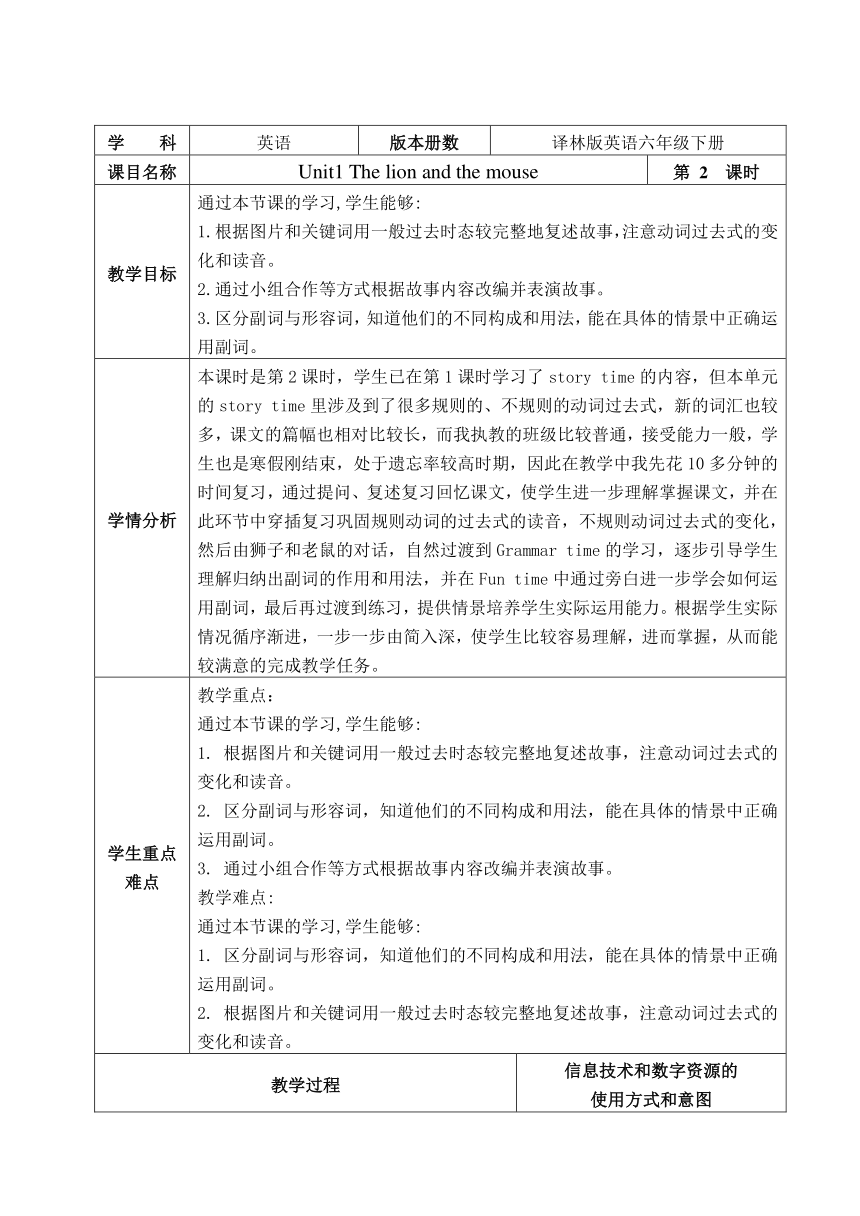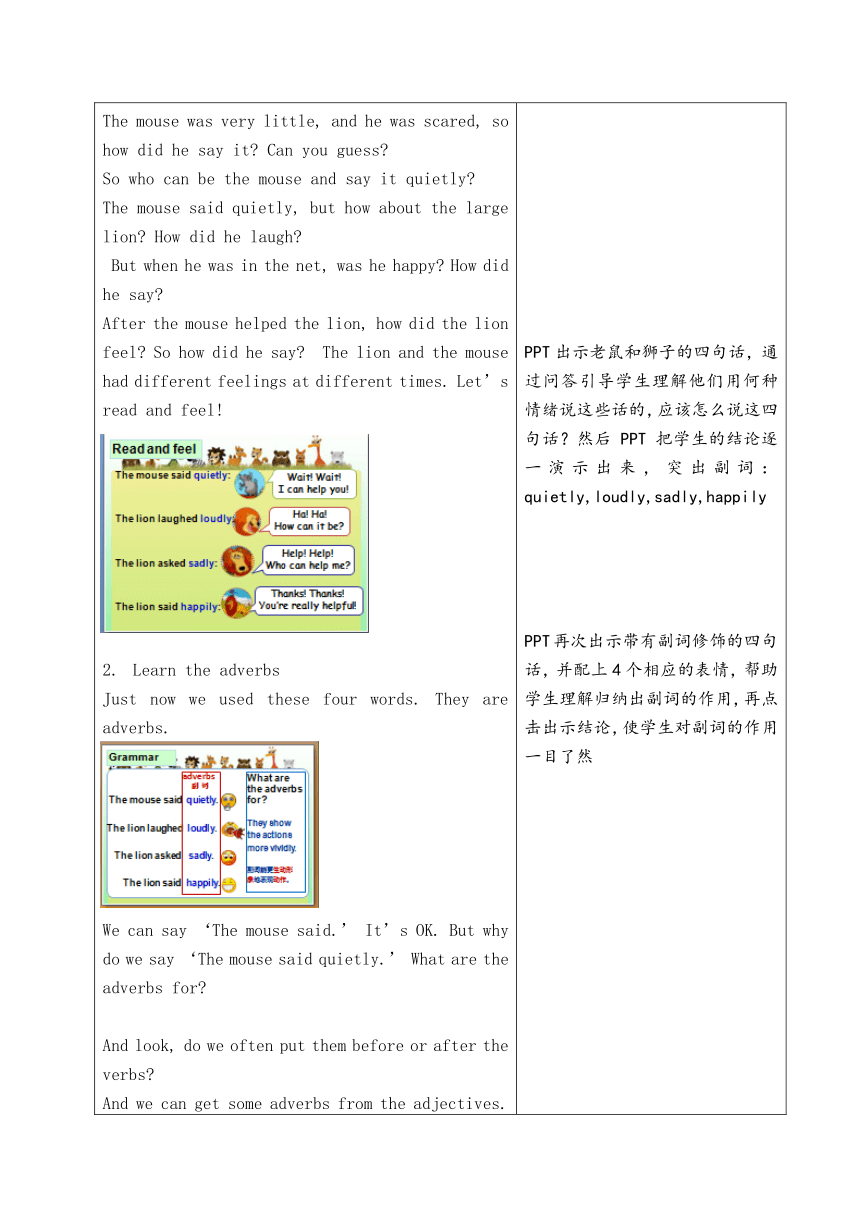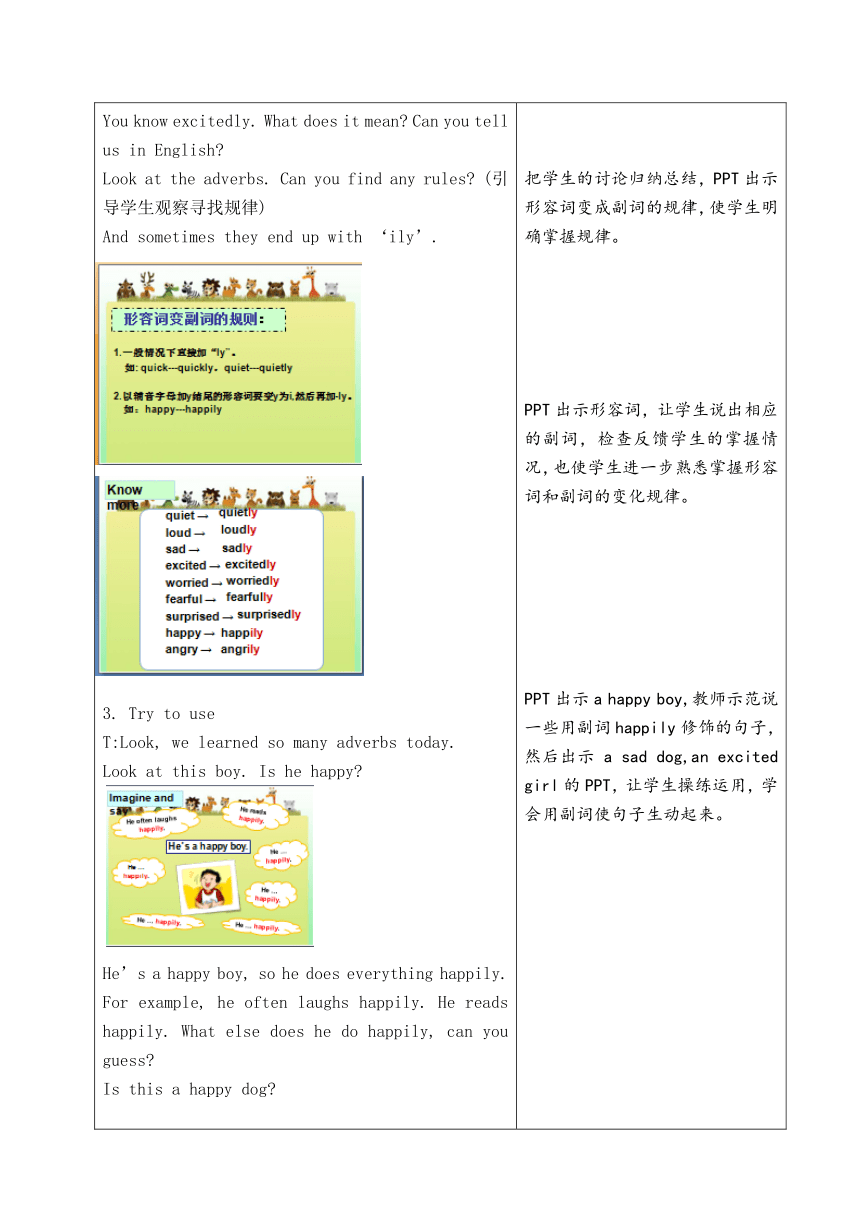Unit 1 The lion and the mouse Fun time 表格式教案
文档属性
| 名称 | Unit 1 The lion and the mouse Fun time 表格式教案 |  | |
| 格式 | zip | ||
| 文件大小 | 438.6KB | ||
| 资源类型 | 教案 | ||
| 版本资源 | 牛津译林版 | ||
| 科目 | 英语 | ||
| 更新时间 | 2020-04-24 12:34:32 | ||
图片预览




文档简介
学 科
英语
版本册数
译林版英语六年级下册
课目名称
Unit1 The lion and the mouse
第 2 课时
教学目标
通过本节课的学习,学生能够:
1.根据图片和关键词用一般过去时态较完整地复述故事,注意动词过去式的变化和读音。
2.通过小组合作等方式根据故事内容改编并表演故事。
3.区分副词与形容词,知道他们的不同构成和用法,能在具体的情景中正确运用副词。
学情分析
本课时是第2课时,学生已在第1课时学习了story time的内容,但本单元的story time里涉及到了很多规则的、不规则的动词过去式,新的词汇也较多,课文的篇幅也相对比较长,而我执教的班级比较普通,接受能力一般,学生也是寒假刚结束,处于遗忘率较高时期,因此在教学中我先花10多分钟的时间复习,通过提问、复述复习回忆课文,使学生进一步理解掌握课文,并在此环节中穿插复习巩固规则动词的过去式的读音,不规则动词过去式的变化,然后由狮子和老鼠的对话,自然过渡到Grammar time的学习,逐步引导学生理解归纳出副词的作用和用法,并在Fun time中通过旁白进一步学会如何运用副词,最后再过渡到练习,提供情景培养学生实际运用能力。根据学生实际情况循序渐进,一步一步由简入深,使学生比较容易理解,进而掌握,从而能较满意的完成教学任务。
学生重点难点
教学重点:
通过本节课的学习,学生能够:
1. 根据图片和关键词用一般过去时态较完整地复述故事,注意动词过去式的变化和读音。
2. 区分副词与形容词,知道他们的不同构成和用法,能在具体的情景中正确运用副词。
3. 通过小组合作等方式根据故事内容改编并表演故事。
教学难点:
通过本节课的学习,学生能够:
1. 区分副词与形容词,知道他们的不同构成和用法,能在具体的情景中正确运用副词。
2. 根据图片和关键词用一般过去时态较完整地复述故事,注意动词过去式的变化和读音。
教学过程
信息技术和数字资源的
使用方式和意图
Step 1 Review Story time
1. 回答问题,写下关键词。
T示范提问1,2个,选取小组提问PK。
Q: How was the lion the mouse?
Q: What did the mouse do one day?
Q: What did the lion do ?
Q: How did the two men catch the lion?
Q: What did the lion feel?
Q: What did the mouse do then?
Q: How did the mouse help the lion?
Q: What did the lion and the mouse become?
2. 根据时间和关键词,尝试复述课文
Please pay attention to the time. Can you find it ?
One day;The next day;Just then;From then on …
Try to retell the story according to the Bb
Step 2 Grammar time
1. Read and feel
In this story, the mouse and the lion said something. What did they say? How did they feel at that time? Can you try to read and feel?
The mouse was very little, and he was scared, so how did he say it? Can you guess?
So who can be the mouse and say it quietly?
The mouse said quietly, but how about the large lion? How did he laugh?
But when he was in the net, was he happy? How did he say?
After the mouse helped the lion, how did the lion feel? So how did he say? The lion and the mouse had different feelings at different times. Let’s read and feel!
2. Learn the adverbs
Just now we used these four words. They are adverbs.
We can say ‘The mouse said.’ It’s OK. But why do we say ‘The mouse said quietly.’ What are the adverbs for?
And look, do we often put them before or after the verbs?
And we can get some adverbs from the adjectives.
You know excitedly. What does it mean? Can you tell us in English?
Look at the adverbs. Can you find any rules? (引导学生观察寻找规律)
And sometimes they end up with ‘ily’.
3. Try to use
T:Look, we learned so many adverbs today.
Look at this boy. Is he happy?
He’s a happy boy, so he does everything happily.
For example, he often laughs happily. He reads happily. What else does he do happily, can you guess?
Is this a happy dog?
So maybe he does everything sadly. Can you guess and talk in groups?
What about Linda?
So what does she often do? Can you guess?
Step 3 Fun time
Before acting
You showed your ideas excitedly. And how about this lion?
He was excited, too. What did he say?
So at that time, how did he say it?
I think you are all right, and I guess
maybe he said excitedly.(出示excitedly的卡片) But did the animals say excitedly, too?
Maybe. Look, this is a short play of
‘The lion and the mouse’. Before we act, please first work in groups of three and decide the adverbs for their words.
You’ve well prepared, so let’s try to act
Step4 Exercise
.T: I want you to use these words to fill in the blanks. You can do it in your groups. Go!
1.
2.
3.
4.
2.T: So boys and girls. Although life is difficult, life is hard. But we should keep in mind that: To be happy everyday, to smile happily. 板书摆放出笑脸。
Homework:
1. Read Grammar time
2.Do the exercises in the workbook.
3.Listen, read and recite Story time.
通过PPT把学生的回答直观地演示出来,同时复习巩固不规则动词的过去式:
Wake—woke
Catch—caught
Eat—ate
Make—made
Become--became
PPT出示短文,降低复述课文的难度,消除学生的畏难情绪,利关键词的提示,使学生能较容易的完成教学任务,并伴随学生的复述,PPT逐一出示答案,使学生印象深刻,进一步复习巩固掌握课文 。
PPT出示老鼠和狮子的四句话,通过问答引导学生理解他们用何种情绪说这些话的,应该怎么说这四句话?然后PPT把学生的结论逐一演示出来,突出副词:quietly,loudly,sadly,happily
PPT再次出示带有副词修饰的四句话,并配上4个相应的表情,帮助学生理解归纳出副词的作用,再点击出示结论,使学生对副词的作用一目了然
把学生的讨论归纳总结,PPT出示形容词变成副词的规律,使学生明确掌握规律。
PPT出示形容词,让学生说出相应的副词,检查反馈学生的掌握情况,也使学生进一步熟悉掌握形容词和副词的变化规律。
PPT出示a happy boy,教师示范说一些用副词happily修饰的句子,然后出示a sad dog,an excited girl的PPT,让学生操练运用,学会用副词使句子生动起来。
PPT出示图片,为Fun time的学习做铺垫。
学生讨论狮子、老鼠和动物们的说话语气,该用哪种副词说话语气,PPT上演示讨论结果,帮助学生为下一步的表演做准备。
PPT出示表演要求,使学生明白如何合作表演。
通过PPT为学生提供5 个情景,让学生根据图片提供的情景,完成图下的短文,使学生进一步理解形容词和副词的区别,掌握两者的用法。
板书设计
Unit1 The lion and the mouse
excited—excitedly happy—happily
beautiful—beautifully angry—angrily
careful—carefully heavy—heavily
He’s a happy boy.
He laughs happily.
备注:
“教学过程”用宋体小四号;“信息技术和数字资源的使用方式和意图”用楷体小四号;行间距为固定值20。
